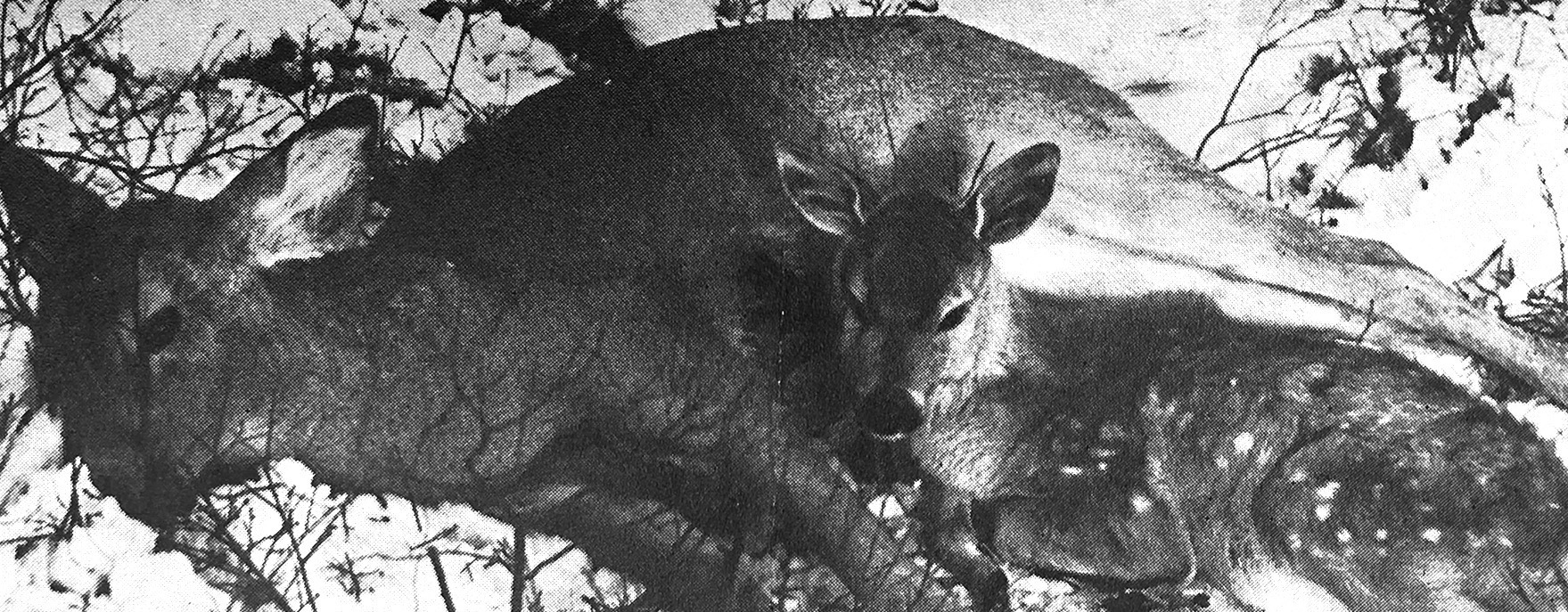Walter E. Hastings was one of those rare fellows from the pretelevision era able to walk interchangeably among academics and buffalo-plaid outdoorsmen.
At one time, he may have been Michigan’s best-known conservationist.
He also had a deep connection with Leelanau County.
“He taught me how to catch fish with a cane pole,” recalled Lou Gatch, an attorney who at 90-years-old still reports on workdays to his desk. “He showed us how to bait hooks and be fishermen.”
Hastings and his wife, Ada, owned a summer cottage on the east shore of south Lake Leelanau among several small lodging buildings collectively known as Amber Sands. A sign designating the cottages is visible from South Lake Leelanau Drive, and Jim and Paula Meyer have owned the resort for more than four decades. It remains a thriving enterprise — the 19th oldest business in Leelanau County, according to its website.
The Hastings owned more than a modest cabin. Their property included a penned area in which Walter Hastings would occasionally take wildlife photos that were published in newspapers throughout the state.
He is a bygone legend. Hastings, the first and foremost outdoor photographer for the Michigan Conservation Department, entertained millions — literally — of Michiganders during the 1920s, 30s, and 40s through their local newspapers and at slide and movie presentations at venues throughout the state. His photos regularly appeared in the Leelanau Enterprise.
He was the recipient of acclamatory letters from three Michigan governors, has a museum named after him, and in letters and newspaper articles of his time, was credited with instilling a much-needed dose of consciousness into the mindsets of sportsmen who were taught that Mother Nature provided a never-ending source of venison and fresh-fried trout for their families.
Hastings was born in Traverse City in 1887, moved to South Lyon in childhood, and reached adulthood at a time that offered few job opportunities for young men desiring to spend their lives harmonizing with the outdoors. After opening a flower shop downstate, he honed his photography skills on a $10 camera bequeathed to him by his Boy Scout troop.
He was hired in 1927 as the first official photographer for a budding Michigan Conservation Department that was created six years earlier.
Hastings was a complex figure, especially in the 1930s when he was popular. He was a worldly ornithologist who enjoyed shooting grouse, a fisherman who applauded a Lake Leelanau smallmouth that tossed his fly, and a deer hunter whose most famous photograph created backlash against the hunting public.
A story published in the Detroit Free Press dated Jan. 6, 1935, offers the most in-depth capsulation remaining of his fame and personality.
“Walter Hastings is one of the most experienced hunters in the state, but he leaves no carcasses in his wake. Neither does he, through inexpertness, make a mistake and guiltily abandon a dead deer and her wounded fawn. And he’s never shot another hunter by mistake.
His home is filled with trophies of his hunting, mounted to be sure, but on cardboard bases, not stuffed,” the Freep story read.
After eight years on the job, Hastings’ skill in outdoor photography had become legendary. Over three decades, he compiled a library of 11,000 negatives, mostly of critters from field mice to moose, from hummingbirds to eagles.
Read another newspaper story at the time, “Since (joining the Conservation Department), his life has been a constant jump from the woods and fields to banquet tables and gatherings of all sorts to display his pictures and tell the story of conservation. Asked how many persons he had addressed during the years with the department, Hastings answered, ‘Millions.’” I found most of the information about Hastings’ legacy at the Bentley Historical Library in Ann Arbor, where an afternoon spent poring through files of his life — most of them newspaper clippings, typed letters, and black-and-white photos — proved productive and enjoyable. A more in An in-depth version of Hastings’s life will appear in the next edition of Michigan Out-of-Doors magazine.
While looking through an Enterprise article for local contacts.
Three emerged, including Gatch. His stories were rich with detail.
“He was a very big, tall guy,” recalled Gatch, who continues to live near Hastings’ cabin. “He was very kind to my cousin and me and took us out fishing. He was a pleasant person (who) always had a camera and a movie camera.”
Gatch considers Hastings, who once caught a six-pound brown trout on the Boardman River on a fly, as an expert fisherman.
“He knew exactly where to go (in Lake Leelanau). Right off the edge is where he would catch fish like crazy. One day, he caught a 4 1/2-pound bass. When we got back, I said, ‘Do you mind if I take that fish to my cousin’s father?’ We used to compete. He didn’t like the idea because he wanted to put it back in the lake to let him go, but he let me. I didn’t come back right away and here comes Walt mad as hell because I’m still holding the fish,” Gatch said.
Paula Meyer has for decades been passionate about preserving Hastings’ memory. Hastings was a collector of history and nature, which led to the construction of the Walter E. Hastings Museum on the Interlochen Center for the Arts campus in 1955. Unfortunately, the museum is now closed to the public, although a spokesperson said the academy is working with an expert in repatriation. Perhaps someday, Hastings’ collections will be available to all.
Meyer said she was allowed to visit the museum several years ago after securing permission from the academy.
“It’s not a fancy museum, and the photography is all above eye level up and down the aisle. The rock collection is fantastic,” Meyer said.
She strolled by Native American artifacts and artwork, including bead jewelry. “And a gazillion papooses,” she added.
Joe Grant, whose family continues to farm the area, never personally met Hastings but recalled stories about his neighbor told by his father.
“I think Dad did say that he had a deer as a pet,” Grant said.
He believes that many of the Indian arrowheads collected by Hastings came from the Lake Leelanau shoreline near his home, which was likely a winter yarding area productive for hunting.
“At our farm and south where Walt lived, there were a lot of arrowheads. Every day, they said he would walk and find them. We found them when we plowed fields. After Dad went through, we would go look,” Grant said.
Hastings, whose recorded rare bird entries date back to 1916, was the namesake of the Grand Traverse Audubon Club when it formed in 1057. The organization incorporated its present name in 1995, However, a club spokesperson said he maintains an environmental and educational fund in his name.
After retiring from the Conservation Department in the 1940s, Hastings’ work passing along a conservation ethic continued as a teacher of outdoor skills at what is now known as the Leelanau School. He was called “Uncle Walt” by students at the Interlochen summer music camp and the Leelanau School.
His most famous photo, which ran on the front pages of newspapers across the state, was of a wounded fawn nestled in the lap of its dead Mother. He attributed the killings to a lack of conservation ethic held by some hunters of the time and set out to change the mindset of a public transitioning away from over-harvesting wild animals.
One newspaper article in his collection quoted him: “The citizens of Michigan are beginning to appreciate that the wildlife of our state is not solely the property of the hunter and the fisherman to kill or destroy as he sees fit. The enormous tourist and resort business is bringing us all to an appreciation of the fact that wildlife is a natural resource that, in justice, we cannot permit to be destroyed for the pleasure of one class.”
The Hastings moved to Mesa, Arizona for the last years of their lives. He died in 1965 at the age of 78.
And then he was forgotten. You won’t find a Wikipedia page on Walter Hastings. Which is a shame.
Coverage by Alan Campbell








